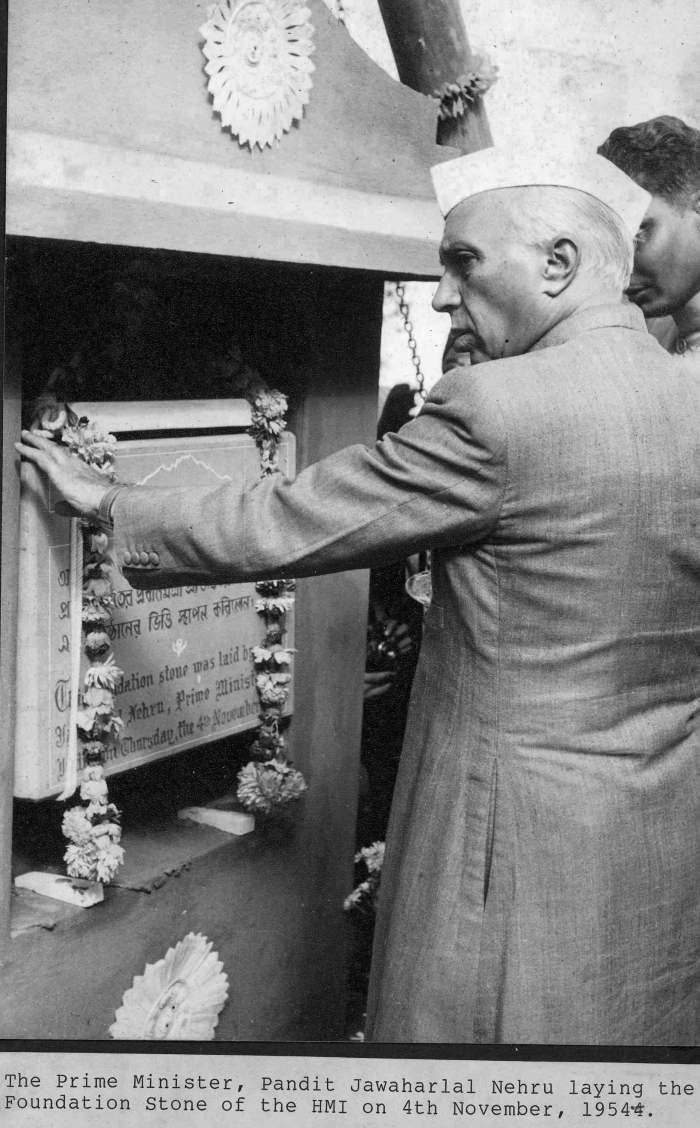
Origin and Growth
Tenzing Norgay’s ascent of Mount Everest (8848m /29,028Ft) along with Edmund Hillary, in 1953, provided the impetus to mountaineering in emerging as an organized sport in India. Pandit Jawaharlal Nehru, the then Prime Minster and a visionary, wanted to channel the abundant energy of the youths of nation into field of mountaineering and hence along with Dr. Bidhan Chandra Roy, the then Chief Minister of West Bengal, planned to open a mountaineering institute in Darjeeling.
The Himalayan Mountaineering Institute (HMI) was founded on 4th November, 1954. Within no time HMI became the centre of excellence in the field of mountaineering. Darjeeling, being the home town of Tenzing Norgay and one of the most beautiful places in Himalaya, was selected as the location of the Institute.
Pandit Jawaharlal Nehru ignited the spark of a new script of challenge & pursuit of adventure in young Indians. The spark has already developed in to a dazzling torch lighting the path for those who accept the challenge of the mountains and aspire to climb high.
Initially the Institute was started at Roy Villa at Lebong Cart Road where Sister Nivedita, one of the greatest disciples of Swami Vivekananda, spent her last few days. The HMI was shifted to its present location on the western spur of Birch Hill in 1958. Besides being a mountaineering institute of repute, HMI has become an important centre of tourist attraction. It commands a magnificent view of the 8586 M high Kanchenjunga, the third-highest peak in the world. In its 62 years of existence, the institute has trained more than 45.000 students including 2500 from abroad. A certificate from HMI is a prized possession of all trainees. It is not only recognized by UIAA but also considered a hallmark in the field of mountaineering training.
The Institute trains young men not only to climb Himalayan peaks, but also create in them an urge to climb peaks of human endeavour, the Himalayas from time immemorial had attracted people and inspired them to discover nature’s bountiful gifts found there and influenced Indian minds as evident from old scriptures, books and epics of the mythology of India.
– Pandit Jawaharlal
The principal objectives of the Institute are: –
(a) To impart theoretical and practical training in mountaineering and rock climbing.
(b) To awaken interest in mountaineering and love for mountains.
(c) To train the enterprising members of the community, who in turn, help in promoting mountaineering activities in the Himalayas as a sport or as a scientific pursuit.
The Himalayan Mountaineering Institute (HMI) is one of the premier mountaineering institutes in the world. Founded on November 4, 1954 by none other than Pandit Jawaharlal Nehru, the first Prime Minister of India, the institute is located in the picturesque hill station of Darjeeling.
Darjeeling is also the hometown of Sherpa Tenzing Norgay, the first human to set foot on the highest peak of Mount Everest along with Sir Edmund Hillary. It was in HMI that Tenzing spent most of his post-Everest ascent period as Director of Field Training. HMI is now a prominent landmark of Darjeeling and a Centre of tourist attraction, it commands a magnificent view of Mount Kanchenjunga, the third-highest peak in the world.
In more than 70 years of its existence, the Institute has trained more than 50,000 thousand students including 5,000 from different foreign countries. The prestigious Course completion certificate from HMI is a prized possession of any trainee, which is given due recognition all over the world.
HMI boasts of a lineage of very illustrious luminaries. Tenzing Norgay was associated with HMI as its Director of Field Training from June 1954 to May 1976. He was then appointed Advisor in May 1976 and was the guiding spirit of the Institute till his death in May 1986. Nawang Gombu, who became the first man to climb Mt. Everest twice was an instructor at HMI since its inception in 1954. He succeeded Tenzing as Director of Field Training at HMI in 1976 and continued to give his valuable contribution to the institute till his death in 2011. Dorjee Lhatoo, another distinguished mountaineer who scaled Everest, Chomolhari, Matterhorn and Nanda Devi peaks among others started as an instructor at HMI and later became Deputy Director of Field Training. Though retired from service now, he continues to give his valuable suggestions for the betterment of the Institute. Nima Tashi is also among the dozen instructors at HMI, his contribution through his lectures and talks popularized mountaineering and adventure all over the country.
HMI provides state-of-the-art facilities to its trainees. It boasts of a well-furnished hostel facility for the trainees which can accommodate up to 150 trainees at one time. It has modern training facilities like indoor and outdoor climbing walls and a well-stocked library which has over 2800 books, mostly mountaineering and books also on travel, exploration, astronomy, geology, flora and fauna.
HMI has the oldest mountaineering museum in the country which was established in 1957. it serves as a centre of educational research on mountaineering activities both for trainees and research scholars, it has a rich collection of models, paintings, sculptures, photographs, manuscripts, autographs, books and mountaineering equipment belonging to famous mountaineers.

